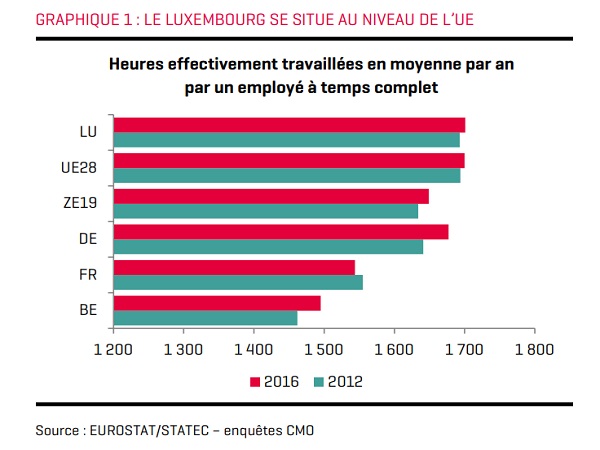 Credit: Statec
Credit: Statec
Statec has revealed that a full-time employee in Luxembourg works on average 1,701 hours per year.
Whilst the figure reflects the European Union average (1,700), it exceeds that of the euro area (1,649) and those of neighbouring countries. In comparison, the average full-time employee in Germany currently works 1,677, whilst in France the number drops to 1,544 and in Belgium to 1,495 hours per year. Statec found that working hours in Luxembourg are higher in all sectors of activity in France and Belgium, as well as higher in most sectors in Germany, with the exceptions of the health and social services sector and the hotel and catering industry.
While the percentage of part-time workers has increased in the Grand Duchy (from 13.2% in 2008 to 17.5% in 2012 and 18.3% in 2016), it remains below the EU (26.0%) and euro area average (28.1%). Among the neighbouring countries, only France has a similar rate (17.7%, slightly lower than in 2012), while more than a third of employees work part-time in Germany (36.9%) and in Belgium (42.2%). In the Netherlands, more than half of employees work part-time (55.1%).
Concerning part-time working hours, part-time employees in Belgium, Germany and the Netherlands work on average half of the hours of a full-time job, whilst in Luxembourg, this percentage is 57%. Part-time employees in France work on average 68% of full-time hours.
Meanwhile, the number of overtime hours worked fell sharply after the economic crisis, from an average of 46 hours for a full-time employee in 2008 to 31 hours in 2012. In 2016, this figure increased again slightly to 32 hours on average for the whole economy (excluding public administration). However, the situation diverges strongly according to the sector of activity, for instance the transportation sector still has a high number of overtime hours (62 hours). The administrative and support service sector remains the second sector to post more than an additional hour per week on average (53 hrs). It is in medium-sized enterprises (from 50 to 249 employees) that the number of overtime hours is the highest.








